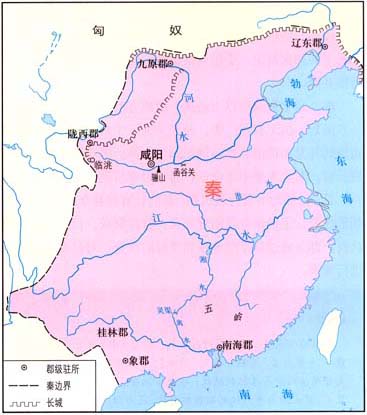秦朝
General
概况
Much of what came to constitute China Proper was unified for the first time in 221 B. C.
中国本土的大部分地区在公元前221年获得了统一。
In that year the western frontier state of Qin, the most aggressive of the Warring States, subjugated the last of its rival states. (Qin in Wade-Giles Romanization is Ch’in, from which the English China probably derived.)
那一年,战国时代最具野心的国度——地处西陲的秦国征服了最后一个对手。(“Qin”在威玛妥式拼音法里的发音是“Ch’in”,这也是“中国”英文发音的来源。)
Once the king of Qin consolidated his power, he took the title Shi Huangdi (First Emperor), a formulation previously reserved for deities and the mythological sage-emperors, and imposed Qin’s centralized, nonhereditary bureaucratic system on his new empire.
秦朝的国君一确立自己的统治,就自称“始皇帝”(意为“第一问君主”),这个名字原先称呼神和神话中的圣明天子的,现在则被始皇帝用来描述秦国的集中且非世袭的官僚体制。
In subjugating the six other major states of Eastern Zhou, the Qin kings had relied heavily on Legalist scholar-advisers.
在征服东周的其他六个主要国家时,秦国曾经非常依赖与法家学派的谏言者。
Centralization, achieved by ruthless methods, was focused on standardizing legal codes and bureaucratic procedures, the forms of writing and coinage, and the pattern of thought and scholarship.
从冷酷的执政下获得的中央集权关注于标准化的法令和官僚流程、造币和书写的形式以及学派的思考模式。
To silence criticism of imperial rule, the kings banished or put to death many dissenting Confucian scholars and confiscated and burned their books.
为了消除人们对于帝国统治的异议,秦始皇放逐或处死了许多持不同意见的儒家学派学者,并把他们的典籍没收和焚烧。
Qin aggrandizement was aided by frequent military expeditions pushing forward the frontiers in the north and south.
秦朝的扩张是借助于频繁的军事远征来扩大其版图的北部和南部。
To fend off barbarian intrusion, the fortification walls built by the various warring states were connected to make a 5 000-kilometer-long great wall.
为了抵御蛮族人的进犯,由战国的一些国家建造的防御城墙被连接起来构成了一个长达5000千米的长城。

What is commonly referred to as the Great Wall is actually four great walls rebuilt or extended during the Western Han, Sui, Jin, and Ming periods, rather than a single, continuous wall.
我们通常所说的长城其实是在西汉、隋朝、晋朝和明朝时期重建和扩展的四座长城而不是一座单一的持续了很长时间的长城。
At its extremities, the Great Wall reaches from northeastern Heilongjiang Province to northwestern Gansu.
长城最远从黑龙江省的东北部一直延伸至甘肃省的西北部。
A number of public works projects were also undertaken to consolidate and strengthen imperial rule.
还有其他一些公共事业项目在进行以稳固和强化帝国的统治。
These activities required enormous levies of manpower and resources , not to mention repressive measures.
这些活动需要征集大量的人力和物力,更不必说一些镇压措施了。
Revolts broke out as soon as the first Qin emperor died in 210 B. C.
秦始皇在公元前210年一去世,反叛就立刻爆发了。
His dynasty was extinguished less than twenty years after its triumph.
他的王朝在胜利之后仅仅存在了不到20年。
The imperial system initiated during the Qin dynasty, however, set a pattern that was developed over the next two millennia.
然而,由秦朝首创的国家体系为今后两千多年的朝代建立了模式并得以发展。


